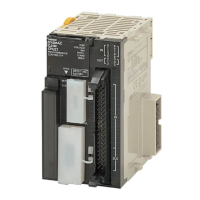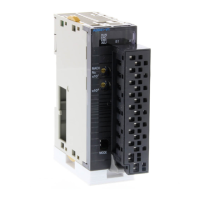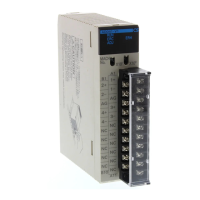115
To create delays, the Completion Flags for two TIM are used to determine
the execution conditions for setting and reset the bit designated for
KEEP(11). The bit whose manipulation is to be delayed is used in KEEP(11).
Turning ON and OFF the bit designated for KEEP(11) is thus delayed by the
SV for the two TIM. The two SV could naturally be the same if desired.
In the following example, 00500 would be turned ON 5.0 seconds after
00000 goes ON and then turned OFF 3.0 seconds after 00000 goes OFF. It
is necessary to use both 00500 and 00000 to determine the execution condi-
tion for TIM 002; 00000 in an inverse condition is necessary to reset TIM 002
when 00000 goes ON and 00500 is necessary to activate TIM 002 (when
00000 is OFF).
00000
00500 00000
TIM 001
TIM 002
005.0 s
003.0 s
00000
00500
5.0 s
3.0 s
TIM 001
#0050
S
R
KEEP(11)
00500
TIM 002
#0030
Address Instruction Operands
00000 LD 00000
00001 TIM 001
# 0050
00002 LD 00500
00003 AND NOT 00000
00004 TIM 002
# 0030
00005 LD TIM 001
00006 LD TIM 002
00007 KEEP(11) 00500
The length of time that a bit is kept ON or OFF can be controlled by combin-
ing TIM with OUT or OUT NO. The following diagram demonstrates how this
is possible. In this example, 00204 would remain ON for 1.5 seconds after
00000 goes ON regardless of the time 00000 stays ON. This is achieved by
using 01000 as a self-maintaining bit activated by 00000 and turning ON
00204 through it. When TIM 001 comes ON (i.e., when the SV of TIM 001
has expired), 00204 will be turned OFF through TIM 001 (i.e., TIM 001 will
turn ON which, as an inverse condition, creates an OFF execution condition
for OUT 00204).
Example 4:
One-Shot Bits
Timer and Counter Instructions Section 5-12

